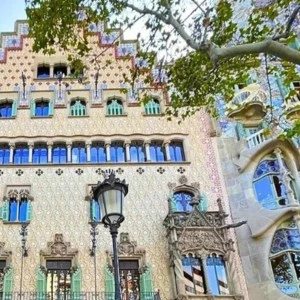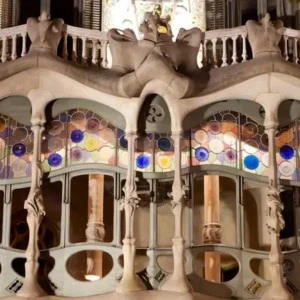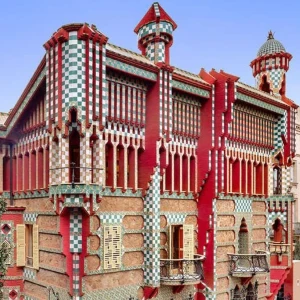
Casa Mila, also known as La Pedrera, is one of Antoni Gaudí’s most iconic works and was his last residential building before he dedicated himself to the Sagrada Família.
It was built between 1906 and 1912 in the heart of Barcelona.
More than a million tourists visit the building every year.
Here you will find everything you need to know before buying your Casa Mila tickets.
Top Tickets
# Casa Mila admission ticket
# Night tickets
# The Barcelona PassIt’s highly recommended to book your tickets in advance. These tickets sell out quickly, so securing your spot early ensures you don’t miss out on this unforgettable experience.
What’s ahead
Where to buy tickets and how do they work
Related Reads
Around 3,000 tourists visit Casa Mila every day, which results in long queues at the ticket counters.
We suggest you get your tickets online – they are €1 cheaper than when you buy them at the venue, and you also skip the long lines.
Immediately after purchase, tickets are sent to your email. You can show them on your phone upon arrival – no need for printouts.
Arrive at least 10 minutes before your scheduled entry time.
Casa Mila tickets
More than 90% of visitors opt for the Casa Mila Essential tour, which is the most affordable way to explore this architectural masterpiece.
For a more romantic experience, consider the night tour.
It also offers a premium ticket, which allows you to enter at any time, and a guided tour that grants access to hidden areas of the site.
Casa Mila offers free entry to kids aged six and below.
Casa Mila Essential Ticket
This is the most popular and most affordable way to explore this Gaudí masterpiece.
When booking this ticket, you can choose your preferred entry time from slots ranging from 9 am to 5 pm.
This ticket also includes a video guide, enhancing your experience.
Adult (18 to 64 years): €29
Youth (7 to 12 years): €12.50
Senior (65+ years): €19
Student (with ID): €19
Disabled visitor: €20
Casa Mila Night Experience
Casa Mila’s night experience happens between 7 pm to 10 pm and is also known as ‘The Origins Show.’
It is a 80-minute semi-guided tour focusing on the origins of life and the essence of Gaudí’s architectural style.
As part of the tour, you will see multiple projections in the stairwells and make your way to the roof terrace for the 20-minute finale.
With fascinating light projections and a background soundtrack, the whole show leaves a memorable mark on visitors.
At the end of the show, you will receive a glass of Cava and sweetmeats to bring you back to Earth.
Adult (18+ years): €39
Child (7 to 17 years): €19
Related: Plan your visit to Gaudí’s Sagrada Família
Casa Mila Sunrise Ticket
The Casa Mila Sunrise ticket gets you onto the roof of Gaudi’s building between 8 am to 9 am, so that you can see the city come to life.
The early-morning guided tour happens well before the crowds arrive.
Enjoy exclusive access to areas usually closed to visitors while learning about Gaudí’s inspiration and architectural techniques.
Adult (18+ years): €39
Child (7 to 17 years): €19
Related: Guide to visiting Park Guell
Casa Milà: Guided Tour
The Casa mila guided tour is available only on Tuesdays and Thursdays at 5 pm.
Where a guide will lead you explaining the attraction to a group of 30 or below.
The tour is available in both English and Spanish. And you will be provided with a radio system to hear your guide better.
Buy This TicketInsider Tip: Casa Mila also offers a premium tour, which is open only for a small group of six people or less. Just that it is highly priced at €120 per person.
3 Houses of Gaudi
Make the most of your holiday in Barcelona with this all-in-one Gaudí pass. Visit three of his iconic masterpieces—Casa Batlló, Casa Milà, and Casa Vicens—with a single ticket.
Enhance your experience with a downloadable Barcelona audio guide, available in six languages, offering insights into over 100 city landmarks, including Park Güell, Sagrada Família, and La Rambla.
Navigate the city with a digital map and enjoy expert commentary at each stop.
Buy This TicketRelated: The ultimate Gaudi Tour in Barcelona
FAQs about tickets
Here are some questions tourists ask before purchasing their tickets for Casa Mila.
Does Casa Mila offer free tickets?
Unfortunately, Casa Mila doesn’t offer free tickets. However, children up to six years, members of the International Council of Museums, and companions of guests with a disability of 65% get free entry every day.
Can I buy tickets at the venue?
Yes, tickets are available at the venue’s ticket office. However, the popular time slots may sell out due to high demand, so it’s better to get them online in advance.
What is the arrival time?
You must select a preferred visit time when you book tickets for the attraction. Considering the time required for security checks, we recommend arriving at least 10 minutes before the time on your ticket.
What is the venue’s late arrival policy?
Entry to the attraction could be denied in case of late arrival.
Does Casa Mila offer discounts for locals?
Catalonia residents can pay a discounted price of €12.50 to avail entry to Casa Mila.
Does the museum-house offer a student discount?
Yes, the attraction offers a student discount of €10 on the Casa Mila Essentials ticket, upon presentation of a valid student ID. While regular visitors pay €29, students end up paying only €19.
What is La Pedrera’s refund policy?
This attraction in Barcelona has a flexible cancellation policy. You can cancel your ticket up to 24 hours before your visit for a full refund.
How can we reschedule the attraction’s ticket?
Casa Mila does not allow you to change the date and time of your visit under any circumstances.
Does the Barcelona City Card include access to the attraction?
Yes, you can explore the city’s top attractions, including the La Pedrera (Casa Mila) and Mirador Torre Glòries Skydeck.
The Barcelona City Card is a cost-effective option to explore the best attractions in Barcelona with a single pass over 2, 3, 4, or 5 days – your choice!
Make the most of the guided tours, museums, landmarks, and other iconic sites like Sagrada Família, Casa Batllo, and Park Guell with this pass.
What is Casa Mila’s rain policy?
In the event of rain, the roof terrace will be closed for safety reasons.
Why is Casa Mila called La Pedrera?
The house’s original name was Casa Mila, after its owners, the Milà family. However, locals gave it the nickname ‘La Pedrera’ (meaning ‘the quarry’.)
While constructing the building, Gaudi attached large stone slabs to the facade, which stonemasons then sculpted. With its irregularly shaped stone slabs, the facade reminded locals of a quarry.
However, Gaudí fans sometimes refer to it as ‘Casa Mila Gaudi’ or ‘La Pedrera Gaudi.’
Short on time? Not sure whether to visit Casa Mila or Casa Batllo? Here’s everything you need to know to make the best choice.
Opening hours
Casa Mila opens at 9 am every day of the year.
From 1 March to 3 November, it closes at 8:30 pm. During the off-season, from 4 November to the end of February, it closes earlier at 6:30 pm.
The last entry is always 30 minutes before closing.
The upper floors start closing 15 minutes before the building closes.
Thirty minutes after Casa Mila closes for day time tours, it opens for night time tours.
Night tour timings
La Pedrera Night Show is a 80 minute extravaganza, starting half an hour after the attraction closes for daytime tours.
From 1 March to 3 November, night tours start at 9 pm and end at 11 pm. During the off-season, from 4 November to the end of February, the show begins at 7 pm and ends at 9 pm.
The Night Show runs daily.
Love trivia? Discover fascinating facts about Casa Mila
Best time to Visit
The best time to visit Casa Mila is from 9 AM to 10 AM, when it is least crowded.
If you can’t visit before 10 AM, we suggest trying 4 PM, which is the next best time.
The daytime tours are more popular and attract large crowds throughout the year.
A limited number of visitors are allowed inside at a time, making it one of the most sought-after tours in Southern Europe.
Best time for photography
The best time to visit Casa Mila is in the late afternoon, around 3 pm, especially if you’re a photographer or love capturing Instagram-worthy shots.
The natural light at this time beautifully highlights the building’s unique facade, making for the best photos.
The best spots to take photos include the entry patio, the detailed ceiling, and the intricate staircases, among others.
Sunset is also a great time to visit Casa Mila and capture the stunning chimney stacks and ventilation ducts.
These structures look majestic when photographed against a dramatic sky.
Visual Story: 13 must-know tips before visiting Casa Mila
Casa Mila at night

Tourists visiting at night see the fascinating show ‘Gaudí’s Pedrera: The Origins.’
The Gaudí expert, who acts as your guide, takes tourists through Passeig de Gracia, the courtyards on Carrer de Provença, and the Espai Gaudi (the museum) which is in the attic before reaching the roof terrace.
Once they reach the roof, a show of lights, lasers, and sound explores the origins of the building.
The story is narrated through video mapping projected onto the roof terrace.
After the audiovisual show on the roof, all tourists are offered a glass of Cava (Spanish sparkling wine) at the Carrer de Provenca courtyard.
How to reach
Casa Mila, Gaudi’s last masterpiece, is located on Passeig de Gracia and is one of Barcelona’s top tourist attractions.
If you are traveling by the Barcelona Hop On Hop Off sightseeing bus, ask for the “La Pedrera” bus stop.
If you prefer a Metro, you can board Green Line L3 or Blue Line L5 and get down at Provenca Metro station, located under Avinguda Diagonal and Balmes Street.
The metro station is just a 5-minute walk from the attraction.
You can also board bus routes V15, V17, H10, H8, 7, 22, 24, 6, 33 and 34. and get down at the Passeig de Gracia bus stop.
Try Barcelona Public Transport Travel Card for unlimited access to the transportation networks in the city and its suburbs.
Architecture
La Pedrera has the main structure and the outer skin, or facade.
The stone facade doesn’t bear any load on the main structure.
Steel beams with the same curvature support the facade’s weight by attaching to the main structure.
This original method gave Gaudi the room to design the facade with all the freedom he needed.
With the flexibility to design what he wanted, Casa Mila Gaudi ended up being an asymmetrical building—a rarity.
Roof
Many tourists who have visited this Barcelona attraction believe that the highlight of Casa Milà is its roof.
The experience of climbing up impressive staircases, looking down into the ventilation shafts, and admiring the chimneys makes for a memorable experience.
Pere Gimferrer, an award-winning Spanish poet, described La Pedrera’s stepped roof as ‘The Garden of Warriors.’
The different elements that make up the roof are:*
- Six skylights
- Six staircase exits
- 28 chimneys arranged in different groups
- Two half-hidden vents that help circulate fresh air in the building
The staircases, some shaped like snails, also contain water tanks.
The roof also offers excellent views of Barcelona.
Chimneys
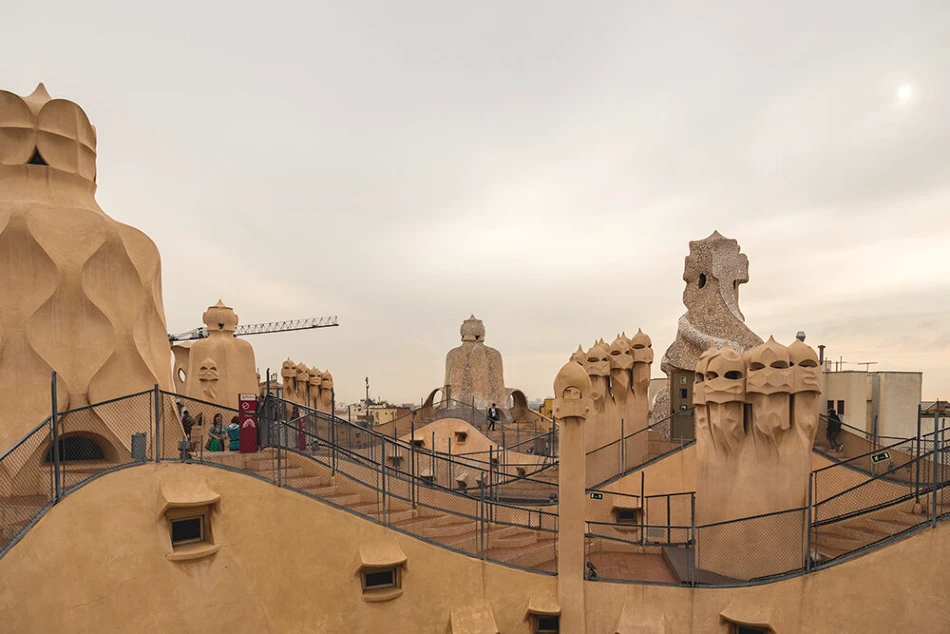
The Casa Milà chimneys on the roof deserve special mention, as they resemble medieval knights guarding the building.
These so-called ‘Chimney Knights’ have a characteristic Gaudí motif: a military spiked cowl with deep eye sockets.
Gaudí believed a structure could be both functional and beautiful, and the chimneys magnificently achieved this balance.
The chimneys are whimsical. They stand out as sculptural artworks, yet they serve a purpose.
One of the chimneys is uniquely topped with fragments of glass.
According to legend, Gaudí himself decorated this chimney with broken pieces of champagne bottles left over from the housewarming party.
The chimneys on the roof of Casa Milà inspired the design of the masks of the Storm Troopers and Darth Vader in the Star Wars films.
What’s inside Casa Mila
Casa Mila is all curves and waves and no right angles.
You will be impressed by everything from the roof to the courtyard, the attic, and the museum within.
The Courtyard

The two separate buildings of Casa Milà meet at this famous courtyard.
The design resembles two waves of water crashing into one another rather than two buildings simply meeting.
The undulating design is mesmerizing.
The enchanting courtyard, adorned with murals featuring floral motifs, is the epitome of Catalan architecture.
The Attic
With as many as 270 parabolic arches supporting the roof, the attic is truly impressive.
The attic, which was initially a laundry room, has now been converted into a museum showcasing Gaudí’s life and art.
Many tourists compare this part of the building to the rib cage of a giant beast.
The Apartment
The main apartment has two parts: the audiovisual presentation room and the famous La Pedrera apartment.
This is where Pere Milà lived with his family.
You can enjoy a journey back in time as the interiors, including the bathroom, kitchen, living room, and bedroom, have been preserved intact.
In addition to constructing the house, Antoni Gaudí was also responsible for the décor, designing furniture and accessories such as lamps, planters, and chairs.
You can see Gaudí’s interior design skills at the Milà family’s apartment, which has been preserved as it was on the fourth floor of La Pedrera.
Gaudi Exhibition
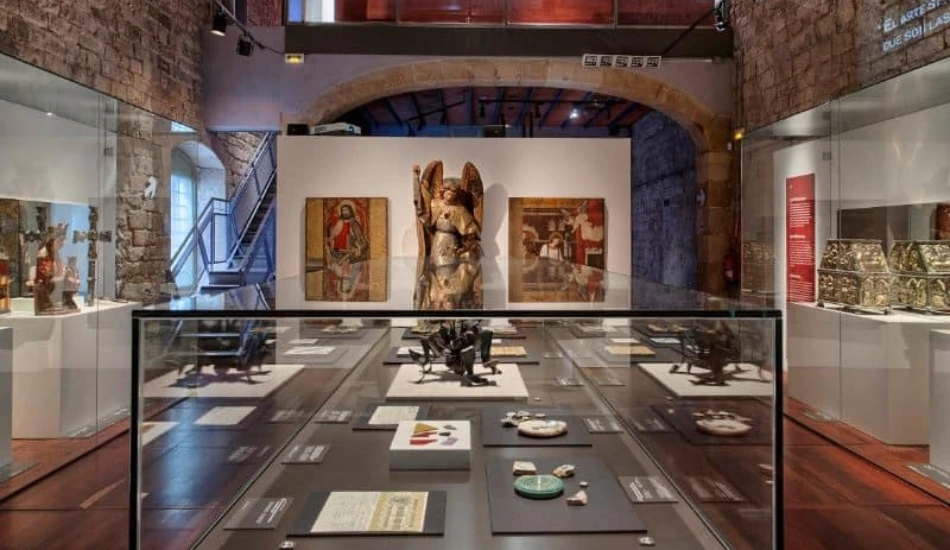
Casa Milà has a permanent Gaudí exhibition in the attic, perhaps the only show devoted to the renowned architect Antoni Gaudí.
You can see videos, models, plans, objects, and designs showcasing his entire body of work.
The apartment where the Milà family stayed during Casa Milà’s heyday has been converted into an exhibition room.
This exhibition is on the main floor of the house.
After Gaudí’s death, Roser Segimon de Milà, the lady of the house, changed much of the décor.
However, some of the sculpted columns and areas of the ceiling designed by Gaudí still exist.

